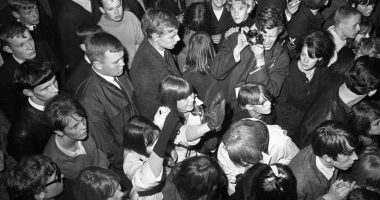
Classes at the Helena’s Rubinstein Beauty Shop, New York City, 1965 | Gottscho-Schleisner Collection, Library of Congress, Prints and Photographs Division | No known restrictions on publication.
TikTok is a social network for making and sharing short videos that has become a global phenomenon beyond the teen market for which it was created in 2018. We explore what it is that makes the experience of using this app based on infinite scroll and algorithmic architecture unique, the experience of time and the circulation of sexual and emotional capital that it offers, as well as the overrepresentation of certain realities to the detriment of others.
Time-lapse stories, animal videos, trap or reggaeton choreographies, lip-synchs to soap opera dialogues, K-pop, experiments with cleaning products and time paradoxes each follow hard on the heels of the last in the infinite zapping of the social network TikTok (Douyin in China). They are tiny nodes, seconds-long compulsions that look at us, study us to give us what we like best and invite us to respond with a new video to viral challenges that invite our participation. As opposed to the exacerbated continuity of gameplay, talk, music and ASMR videos on the streaming platform Twitch, the discontinuity of TikTok awakens the urge to see more, to see something different, a desire to share and be shared that can never be satiated, maybe just momentarily tired.
Video after video, with no interruption to remind us of life outside the app, TikTok, like its rival Triller, and like Instagram, Facebook, Twitter, WeChat and TouTiao, unfolds with swipe after swipe of our Smartphone screens. It may not yet figure as a milestone in anthropology studies or school textbooks, but the year 2006 saw the introduction into human cultural history of a visual device that is as important as the book or the printing press: the infinite scroll, a feature of the touch interface that is the foundation of most contemporary social media. Devised by the engineer Aza Raskin, interface designer, entrepreneur and, in recent years, an activist for the ethical use of technology, the infinite scroll not only catalyses the possibilities of the touch screen, first incorporated in Steve Jobs’s iPhone in 2007, it also constitutes the cognitive reprogramming of our access to information and our conception of emotions and time.
The feed that just doesn’t stop
“The eye only sees what it looks at, and only looks at what it already has an idea of.” These were the words written on a poster at the entrance to his criminal identification classes by Alphonse Bertillon,[1] the creator of judicial anthropometry, whose system was adopted by all police forces in the Western world as of 1888. When we repeatedly swipe the TikTok screen, not only do our eyes recognize those images for which we already have a paradigm of understanding, but the artificial intelligence system developed by the Chinese company ByteDance registers the micro-movements of our thumb, the time we dedicate to each image, our Likes and preferences, while tagging each video to swell the feed with the images that best satisfy our desire to continue glued to that apparently chaotic concatenation of stimuli that has over two billion downloads and peaks of almost one billion active users a month.
Faced with a kaleidoscope that captivates half the world’s population and which, during the pandemic, has broadened its reach beyond its original adolescent market in 2018, it is worth asking what makes the experience of using this app unique. It is not so much about clarifying the multiple narratives that run it through or identifying the leading users, such as Charli D’Amelio, Addison Rae and Bella Poarch (117, 81 and 71.6 million followers), but about asking what does TikTok think? What does TikTok see, what does it look at and what does it not show? How should we think of TikTok? How does it respond to our gaze? And, even, what are we to TikTok? Strictly speaking, viewed from the perspective of social media, human life is an epiphenomenon of its own self-reproduction, whose destiny is to produce and consume content that is reproduced virally. What is truly alive is the circulation of this enormous meme factory, with no beginning and no end.
On each of the smartphones that participate in the TikTok feed, the capitalist ideal of semio-production becomes a reality. It is no longer necessary to produce any specific content, but rather to support an artificial intelligence system that allows users to adapt the incessant production of videos to their own scopic drive. To Shakespeare’s adage “Let every eye negotiate for itself” that filmmaker Jean-Luc Godard chose to open his Histoire(s) du cinéma (1998),[2] the TikTok era responds with a mediated negotiation, a cognitive automatization that dislodges any unexpected image and guarantees the total fluidity of the consumer experience. TikTok is a platform on which being, consuming and producing are the same thing. The factory as the consumer is a chimera that industrial capitalism, which produced goods and learned to create needs, could never have dreamed of.
Further, the fact that adolescents are one of the greatest work forces draws a horizon in which, what Marx in his Fragment on Machines[3] called the general intellect, far from giving rise to a socialization of accumulated technological and cognitive capital, has the opposite effect. There is no possible emancipation of social time from the obligation of salaried work, since it is impossible to use TikTok, Twitch, Instagram, Facebook or any other social network without generating capital, without working. This overlap between life and work that characterizes our performance society obliterates any possibility of leisure without consumption, without Otium ludens in the Latin sense.[4] However, it would be naïve to criticise TikTok without recognising its importance as a phenomenon and the expertise of its algorithmic architecture to represent, in ways that other narratives fail to offer 21st-century users, the emotional tension field, particularly the identitary constellation of adolescence.
What Deleuze, in his 1978 course on Spinoza, called the affectus, “the continuous variation of someone’s force of existing”,[5] is something that the transition between video and video, the socialization that each response entails, eternalizes to an unusual extent. People dance, on TikTok. They laugh. They cry. They sing. They want to please. It is a sublimated projection of our own self, but—unlike Instagram—the floodgates are also open to the exteriorization of states of prostration, crying or euphoria, though almost always brought back to a positive attitude. Emotions are released as a consequence of the “overload of ourselves” that we suffer in a society from which collective rituals and the symbolic dimension of the images that articulate socialization have been stripped. For adolescents in particular, TikTok is a community space capable of catalysing the fantasy of a relational fabric that protects their own identity and the construction of their own emotions.
The accumulation of followers, the affirmation of Likes and the possibility of appearing in the same digital space as TikTokers who are emerging as reference models offer the full celebrity effect, its phantasm generated by the accumulation of personal emotional capital linked to self-exposure. The real driving force of the app is gaining a popularity that coincides with the screen as a projection of the confessional space of the bedroom. The hypervisibilization of intimacy also contributes to a transformation of the social evolution of the psychosphere in which desire, which always has a cultural genesis, is invested with a frenetic or, to use Guattari’s term, chaosmotic quality: [6] TikTok is not a place to share your own sexuality; it is an externalized organ of enjoyment, which explains the aghast reaction of adolescents when its use is limited by an adult.
The sexual capital of late modernity, or how to put an end to Galton
As Slavoj Žižek pointed out, images do not respond to our desire; they do not teach what to desire, but how to desire.[7] Since, in 1907, Julius Newbronner devised a system to attach a camera to the chest of a pigeon, our gaze has not ceased to be externalized. First, it was aeroplanes, then, as Harun Farocki warned,[8] video surveillance and missiles launched during the Gulf War, then networks and algorithms. Today, although we are the ones recording ourselves and giving our facial expressions to applications like FaceApp or the locking system of our Smartphone (the culmination of Bertillon’s classification system, his “spoken portraits”), our gaze is completely externalized. From the pioneering aerial view of Kronberg taken by Newbronner’s pigeon to the Chinese Dragonfly Eye surveillance system, the image has become automated to the point of losing the two principles of its own definition: produced by a human being to be seen by a human being.
From cognitive automation, we have moved to eliminating any blind spots, as shown by the expansion of Axon and AnyVision’s surveillance systems. If, in the public space, hypervisibility is the norm, as the Chinese social credit system shows, social networks promote a neuro-totalitarianism based on the patrimonialization of Eros and collective time. Given the TikTok sequence, the experience of time is simultaneously articulated and destroyed—that is, at each moment, time is directed through stories and pseudo-rituals, and simultaneously destroyed by the appearance of the next video. The coincidence of ritual and play on social networks causes a fracture in their place in time that is accompanied by a phenomenon of capitalization. We accumulate capital not only to survive but also as a way to confound death, as a fantasy of survival. And we accumulate sexual capital, as Eva Illouz and Dana Kaplan point out, as a result of an anomalous interference between the realm of the economy and the long sociocultural process that, for decades, led to the identification of sexual freedom with self-realization.[9]
The primary eroticization running through social networks shows how sexuality, once freed from the control of institutions like the family or the church, has ceased to be the space of unassailable freedom. In a society that substitutes the control and biopolitics described by Foucault with self-exploitation and performance,[10] personal attractiveness becomes part of mercantile logic, in what Illouz calls “scopic capitalism”.[11] As Catherine Hakim points out, erotic capital has always existed in different forms and it is necessary to banish a binary reading of empowerment and domination, since it is a more complex phenomenon.[12] The fact that sexual freedom is the normative basis of capitalism does not prevent inequality or even sexual declassification becoming the order of the day, with the hypervisibility of networks such as TikTok, or OnlyFans, with its erotic plus.
From the behavioural point of view, furthermore, according to Hito Steyerl, the choreographic language projected by social networks generates a domestication of gestures, a discipline of bodies in which empowerment coexists, without contradiction, with submission to the Market.[13] A phenomenon like DeepTok, with its grim images and videos of animal torture, prompts a reaction of the collective sensibility against TikTok’s all-encompassing capacity to assimilate. Likewise, as in any other social network, the over-representation of certain realities means the under-representation of situations like Chinese repression against the Uighur Muslim majority ethnic group or the use of “re-education camps”, something that teenager Feroza Aziz managed to denounce in November 2019 using a makeup video, immediately removed from TikTok.
Persistences of vision
One of the most equivocal figures in the history of science, Sir Francis Galton, eugenicist and inspiration for the racial hygiene policies of Nazi Germany, created a system of composite photography in which he tried to establish a series of figurative canons—with labels such as “genius”, “Jew” or “criminal”—that allowed him to predict people’s behaviour by means of a pictorial statistic created from superpositions into which he tried to read natural classes. Due to the capriciousness in the definition of these types, based on his prejudices, the images had a spectral aspect, the sum of thousands of portraits in which Bertillon’s biometric segmentation was transformed into non-existent chimeras, blurred beings that look out at us waiting for a match with traits drawn to satisfy a statistical anatomy.
Faced with the machine learning that governs TikTok, and its circulation of sexual and emotional capital, we might wonder whether, for its artificial intelligence, we are not the citizens whose future Galton was trying to capture: docile bodies consumed in a perpetual exploitation of the self. But no science leaves the ego intact, as Donna Haraway points out in The Persistence of Vision.[14] Today, a true science of images must be based on TikTok’s mapping of affects to consider the opportunity of reconquering an emotional language expropriated by the attention economy. As opposed to Aristotle’s idea that pathos, unlike logos, is deprived of action and will, a long line of thinkers from Nietzsche to Judith Butler has pointed out that the exposure of emotion, of affect, is movement, openness and power, which leads us to wonder not only who we are to TikTok and how it models our emotions, but also is there any way to reprogram it?
[1] Bertillon cites this phrase in Identification anthropométrique, instructions signalétiques (Imprimerie Administrative, 1893) based on the epigraph that anatomist Jean Louis Hippolyte Peisse takes from Paul Richter’s Traité d’Anatomie artistique (Paris: Plon, 1890): “L’Oeil ne voit dans les choses que ce qu’il y regarde et il ne regarde que ce qui est déjà en idée dans l’esprit.”
[2] “Let every eye negotiate for itself”, Shakespeare, William, Much Ado about Nothing (1599) Act II, scene I (1978: The Complete Works (The Alexander Text) 18th edition, London, Collins, p. 143).
[3] Marx, K.: Elementos fundamentales para la crítica de la economía política (Grundrisse) 1857-1858, vol. 2, Mexico. Siglo XXI, 1972, pp. 216-230.
[4] See: Guzzo, P.G. and Bonifacio, G. (ed.). Otium Ludens. Stabiae, cuore de l’impero romano. Castellammare di Stabia:N. Longobardi: 2007; Fumaroli, M. París-Nueva York-París. Viaje al mundo de las artes y de las imágenes. Diario de 2007 a 2008. Barcelona: Acantilado, 2010,
[5] Deleuze, G., En medio de Spinoza. Buenos Aires: Cactus, 2006.
[6] Guattari, F.: Caosmosis, Manantial, 1996.
[7] In: Fiennes, S., Žižek, S.: The Pervert’s Guide to Cinema (2006).
[8] Farocki, H.: Eye Machine I y II (2001, 2002); “Der Krieg findet immer einen Ausweg”, Cinema 50, Essay, Schüren Verlag, 2005.
[9] Illouz, E. and Kaplan, D.: El capital sexual en la modernidad tardía. Barcelona: Herder, 2020.
[10] Foucault, M.: Histoire de la sexualité. Paris: Gallimard, 1976; Surveiller et punir, Gallimard, Paris, 1975; Naissance de la biopolitique, Cours au collège de France 1978-1979, Hautes études, Gallimard-Seuill, París, 2004.
[11] Illouz, E.: El fin del amor. Una sociología de las relaciones negativas. Buenos Aires: Katz, 2020.
[12] Hakim, C.: “Erotic capital”, European Sociological Review 26.5, 2010.
[13] Steyerl, H.: “¡Corten! Reproducción y recombinación”, in: Los condenados de la pantalla. Buenos Aires: Caja Negra, 2014, pp. 185-200.
[14] Haraway, D.: Primate Visions, Gender, Race and Nature in the World of Modern Sciences. New York: Routledge, 1989.





Leave a comment